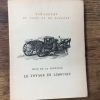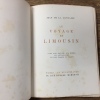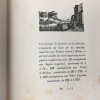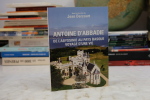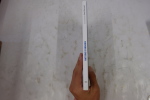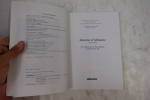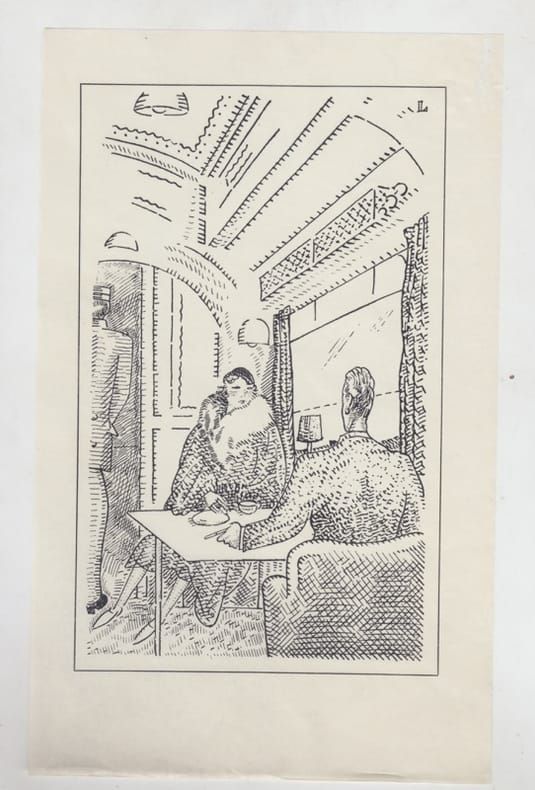-
Type
Autograph (3)
Book (23809)
Drawings (9)
Engraving (16)
Magazine (132)
Manuscript (5)
Maps (20)
Music sheets (41)
Old papers (3)
Photographs (8)
Postcards (2)
Posters (1)
Public sale (1)
-
Latest
Last 24h (24)
Last 3 days (25)
Last month (155)
Last week (22)
-
Language
Czech (1)
Dutch (1)
English (24)
French (24016)
German (3)
Italian (1)
Latin (1)
Spanish (3)
-
Century
16th (9)
17th (83)
18th (545)
19th (4371)
20th (9894)
21st (1177)
-
Countries
Belgium (374)
Canada (44)
Côte d'Ivoire (9)
Denmark (764)
France (21341)
Germany (206)
Greece (4)
Italy (1)
Netherlands (4)
Switzerland (1303)
-
Syndicate
ALAC (44)
CLAM (8)
CLAQ (39)
CNE (13)
ILAB (14433)
NVVA (316)
SLACES (312)
SLAM (13177)
SNCAO (9)
Bernard Buffet - Secrets d'atelier
, Flammarion, 2004 Hardcover, 144 pages, Texte en Francais , Tres belle exemplaire, 320 x 250 x 20 mm, jacquette, illustration en n/b. ISBN 9782080112989.
Aussi c l bre, aussi adul que controvers , Bernard Buffet (1928-1999) a construit son ?uvre avec une r solution tragique. En une symphonie clatante, la vie et la mort s'y inscrivent comme sur le masque d'un clown. La photographie a saisi cela. Cet album est n d'une triple rencontre. Le peintre, la femme aim e et le photographe : en 1958, lors d'un reportage Saint-Tropez, Luc Fournol pr sent Annabel Bernard Buffet. Quarante-cinq ans plus tard, la compagne de toute une vie commente les photographies de Luc, devenu l'ami de toujours. Le premier portrait d'Annabel, la Passion du Christ, les damn s de Dante ou l' preuve de l'autoportrait il fallait la complicit d'un proche pour saisir le combat d'un peintre que l'inqui tude n'a jamais quitt . Car l'intimit d'un artiste, c'est son travail. Et les myst res de l'atelier sont plus difficiles percer que les secrets d'alc ve. Reflets d'une vie partag e entre tendre complicit , et tension cr atrice, les photographies de Luc Fournol et de Benjamin Auger se font l' cho de la sinc rit avec laquelle, chaque tableau, l'artiste remit son titre en jeu. Car si Bernard Buffet a pu se tromper, il n'a jamais trich . En mettant fin ses jours, le 4 octobre 1999, il tira la le on de ce combat qu'il quittait en vainqueur, pour n'avoir jamais renonc sa libert ni aux valeurs qui en faisaient le prix. Ami de jeunesse, t moin amical des v nements de la vie de Bernard Buffet, Luc Fournol, mieux que tout autre photographe, a su dresser le portrait de l'artiste face son ?uvre.
LE VOYAGE EN TERRE SAINTE
IMPACT LIVRE. 2000. In-4. Cartonnage d'éditeurs. Bon état, Couv. convenable, Coiffe en pied abîmée, Intérieur frais. 197 pages. Nombreuses illustrations en couleur, dans le texte et hors texte.. . . . Classification Dewey : 910-Géographie générale. Voyages
Classification Dewey : 910-Géographie générale. Voyages
Tableau de la Grèce en 1825, ou récit des voyages de M. J. Emerson et du Cte Pecchio, traduit de l'anglais () et augmenté d'un précis des événemens qui ont eu lieu depuis le départ de ces voyageurs jusqu'à ce jour, par Jean Cohen, ancien censeur royal
Eymery | Paris 1826 | 12.8 x 20.5 cm | Relié
Édition originale de la traduction française, augmentée de notes par le traducteur (cf. Loukia Droulia 1180. Quérard II 238 ; et VII 6 (à : "Pecchio"). Blackmer 549 et Atabey 396 (à : "Emerson"). L'ouvrage est illustré, en frontispice du premier volume, d'un portrait d'Andrea Miaoulis. Reliure en demi veau bronze, dos lisse orné de frises et de fleurons dorés s'estompant parfois, quelques frottements sur le dos, plats de papier marbré, tranches marbrées, reliure de l'époque. Dos restauré et légèrement frotté, quelques rousseurs. L'édition originale a paru à Londres la même année. Elle contenait aussi le "Journal of a visit to Greece" de Humphrey, rejeté de l'édition française. "Important philhellenic collection () Emerson reached Greece at the end of 1823 and left soon after Byron's death in 1824. In 1825 he returned as a volunteer and was correspondent for the Times, fighting alongside Miaoulis and Makriyannis. The portrait of Miaoulis is after a drawing from life by Emerson. The Italian revolutionary Pecchio had been living in exile in England when he decided to go to Greece for a few weeks because he was "desirous of paying a visit to the members of the Government". He rapidly became disillusioned but was honest in his account, which is very interesting" [Leonora Navari]. Agréable exemplaire, en reliure romantique de l'époque, de ce livre important pour l'histoire du philhellénisme. - Photographies et détails sur www.Edition-Originale.com -


Phone number : 01 56 08 08 85
LES VOYAGES DE RIMBAUD
Éditions Balland, 1 volume cartonné de format 31 x 25,5 cm, jaquette, 318 pages, nombreuses photographies en noir et blanc, très bon état. Frais de port en supplément.
Envoi en colissimo ou par Mondial Relay
Les voyages de Rimbaud.
Balland. 1991. In-4. Relié. Bon état, Couv. convenable, Dos satisfaisant, Intérieur frais. 317 pages - jaquette en bon état - nombreuses photographies en noir et blanc dans et hors texte.. Avec Jaquette. . . Classification Dewey : 910.4-Voyages
Classification Dewey : 910.4-Voyages
L'Asie mysterieuse
Editions de "Sciences et voyages", 1924. Format 14x19, broche, 96 pages. Tres bon etat.
Libye : d'hier et d'aujourd'hui
, ACR Edition, 2002 Hardcover, 323 pages, Francais; 285 x 260 x 30 mm, avec une jacquette, NEUF !! ISBN 9782867701511.
Inconnue de nombreux Occidentaux, la Libye n?est pas autant une attraction touristique que ses voisins l? gypte et la Tunisie. Mais est-ce que quelqu?un devrait s?en plaindre ? Ce pays rec le des sites extraordinaires (dont certains inscrits au patrimoine mondial), comme les cit s antiques de Sabratah et Leptis Magna en Tripolitaine, Cyr ne, Apollonie et Ptol ma s en Cyr na que, et les dirigeants du pays sont conscients que la Libye rec le une richesse de richesses. monuments historiques. Mais le patrimoine du pays ne doit pas se r duire ses vestiges gr co-romains ; il y a aussi des mosqu es des premiers jours de l'Islam, qui sont probablement les seules mosqu es de ce type dans toute l'Afrique du Nord, des constructions urbaines raffin es construites par les Ottomans, des vestiges architecturaux de la pr sence occidentale, tant chr tienne qu'italienne, qui, bien que limit s dans le temps, et m me ph m res, sont pour la plupart assez splendides. Enfin, les trekkings dans le Sahara libyen, avec bivouacs et nuits la belle toile qui font vivre aux visiteurs des exp riences intenses, permettent aux touristes de d couvrir des paysages d sertiques souvent grandioses ainsi que des exemples prodigieux de peintures pari tales uniques au monde.
Les grands voyageurs. Les plus grands textes de Marco Polo et Christophe Colomb à Théodore Monod
Cnrs éditions Paris, CNRS éditions, Le nouvel observateur 2010. In-12 relié plein cartonnage illustré de l'éditeur, sous étui illustré. 484 pages. Préface de Michel le Bris. Collection L'anthologie du savoir. Parfait état
Toutes les expéditions sont faites en suivi au-dessus de 25 euros. Expédition quotidienne pour les envois simples, suivis, recommandés ou Colissimo.
Le Voyage en Limousin avec une notice, des notes, un autographe, et des images du temps
La Renaissance, Paris, 1927, 103 pages. Collection "Voyageurs de jadis et de naguère". Lettres de La Fontaine à sa femme, relation d'un voyage de Paris en Limousin. Extrait d'une lettre en fac-similé, 11 reproductions de gravures anciennes à pleine page et quelques vignettes dans le texte.
Exemplaire n°919 sur vélin Lafuma. Broché, couverture crème illustrée rempliée en bon état. Rousseurs notamment sur les premières et dernières pages. Le dos se désolidarise.
LE ROI DES SCOUTS: hardi " le franc" !...
broché - 12x18 - 64 pp - 1930 - collection aventures voyages n°7- éditions A. FAYARD et Cie ,Paris.
Les cent bateaux
Imp. des papeteries de Normandie | Caen 1932 | 13.50 x 21.50 cm | agrafé
Edition originale dont il n'a pas été tiré de grands papiers. Iconographie. Petites taches sans gravité en pied du premier plat, ex-dono à la plume en tête de la première garde, agréable état intérieur. - Photographies et détails sur www.Edition-Originale.com -


Phone number : 01 56 08 08 85
VOYAGE EN TERRE DE BRESIL
HACHETTE. 2000. In-12. Broché. Bon état, Couv. convenable, Dos satisfaisant, Intérieur frais. 127 pages. Quelques illustrations en noir et blanc, dans le texte.. . . . Classification Dewey : 910-Géographie générale. Voyages
Biblio collège n°26. Classification Dewey : 910-Géographie générale. Voyages
Les delices de la Hollande
Chez Charles Ger Stecoren | à Leide 1660 | 8 x 13.80 cm | relié
Nouvelle édition. Reliure en demi chagrin rouge ca 1820. Dos à nerfs orné de fers Restauration. Titre doré. Frottements. Premier guide touristique français sur la Hollande et qui connut de multiples éditions, notamment au XVIIIe avec figures. - Photographies et détails sur www.Edition-Originale.com -


Phone number : 01 56 08 08 85
Antoine d'Abbadie
2010 chez Atlantica. In-8, broché, 208p. Nombreuses illustrations en couleurs ainsi qu’en noir et blanc. Exemplaire en bon état avec de légères marques d’usure.
SUR LES PAS DES TSARS A SAINT PETERSBOURG + ENVOI DE L'AUTEUR
PERRIN. 1992. In-4. Relié toilé. Bon état, Couv. convenable, Dos satisfaisant, Intérieur frais. 128 pages. Jaquette illustrée en couleurs. Nombreuses photos en couleurs dans et hors texte. Tampon de bibliothèque.. Avec Jaquette. . . Classification Dewey : 910.4-Voyages
Envoi de l'auteur sur la page de faux-titre. Classification Dewey : 910.4-Voyages
SUR LES PAS DE MOZART + ENVOI DE L'AUTEUR
PERRIN. 1991. In-4. Relié toilé. Bon état, Couv. convenable, Dos satisfaisant, Intérieur frais. 143 pages. Jaquette illustrée en couleurs. Nombreuses photos en couleurs dans et hors texte.. Avec Jaquette. . . Classification Dewey : 910.4-Voyages
Envoi de l'auteur sur la page de faux-titre. Classification Dewey : 910.4-Voyages
Manneke-Pis au bon vieux temps / Manneke-Pis in de goede oude tijd / Manneke-Pis in good old days / Manneke-Pis in der guten alten Zeit NL / ENG / FR / D
, Libro-Sciences, 1973, 1973 Hardcover , NL / ENG / FR / D, 145 pagina's/pages/seiten , 120 foto's / illustrations / pictures in z/w / b/w, in goede staat / fine ex / bon etat / gut. ISBN X.
En train, gravure originale de Jean-Émile LABOUREUR,lithographie à la plume
sl,sd,(1930?) sur chine
Remise de 20% pour toutes commandes supérieures à 200 €

En train, gravure originale de Jean-Émile LABOUREUR,lithographie à la plume
1930 sl,sd,(1930?) sur chine
Remise de 20% pour toutes commandes supérieures à 200 €
VOULEZ-VOUS VOYAGER AVEC MOI ?
ARTHAUD. 1957. In-8. Broché. Etat d'usage, Couv. légèrement passée, Dos satisfaisant, Intérieur frais. 244 pages. Premier plat illustré en couleurs. Couverture rempliée. Nombreuses photos noir et blanc hors texte.. . . . Classification Dewey : 910.4-Voyages
Classification Dewey : 910.4-Voyages
ET SI ON ALLAIT FAIRE UN TOUR A LA POINTE? OU DIX ANS D'HISTOIRE DES FRANCAIS EN VACANCES ET EN VOYAGE.
RAMSAY. 1978. In-8. Broché. Etat d'usage, Couv. légèrement passée, Dos plié, Intérieur frais. 290 pages. Premier plat illustré en noir et blanc.. . . . Classification Dewey : 910.4-Voyages
Classification Dewey : 910.4-Voyages
L'art préhistorique en Amérique. Extrait de la Revue des Deux Mondes
Extrait de La Revue des deux mondes | s. l. [Paris] 1883 | 15.50 x 25 cm | agrafé
Edition originale. Sous couverture muette. Rare. - Photographies et détails sur www.Edition-Originale.com -


Phone number : 01 56 08 08 85
Nouveau voyage en Espagne, ou tableau de l'etat actuel de cette monarchie
Chez Regnault | à Paris 1789 | 12 x 20 cm | relié
Second tirage de l'édition originale avec titre de relais, illustrée de 3 cartes dépliantes (Espagne, Madrid et baie de Cadix) dont la carte d'Espagne coloriée, et de 9 planches dont 7 dépliantes. Reliure en demi basane brune d'époque. Dos à nerfs orné de filets gras. Pièce de titre et de tomaison en veau fauve. Coiffe du tome I en partie élimée, arrachée au tome 2, un manque au tome 3 ; queue des tome I et 2 en partie arrachées. Mors inférieur du tome 2 ouvert en queue. mors supérieur du tome 3 fendu en queue. Ensemble très frotté. Bordure du tome I rognée et des autres tomes émoussées. 3 planches portant des déchirures. Mouillure en début du tome II. L'intérêt de ce voyage est de s'occuper de l'Espagne contemporaine à la fin du XVIIIe. Il a été écrit par un témoin direct, l'ambassadeur de France à Madrid, le baron Jean François de Bourgoing. A partir de 1782, il choisit de visiter l'Espagne pour en établir un tableau véritable. Il en présente tous les aspects, économie, commerce, institutions, cuisine... - Photographies et détails sur www.Edition-Originale.com -


Phone number : 01 56 08 08 85
Nouveau voyage en Espagne, ou tableau de l'état actuel de cette monarchie
Chez Regnault | à Paris 1789 | 12 x 19.90 cm | 3 volumes reliés
Edition originale anonyme illustrée de 12 planches dépliantes dont1 carte et 2 plans gravés par Tardieu (Carte enluminée de l'Espagne, Plan de Madrid, Plan de la Baie de Cadix), 8 vues et plans (Passage de la Bidassoa, Château de Sergovie, Aquéduc de Sergovie, Façade du Palais de Saint-Ildefonse, Escurial, , Vue d'Aranjuez, Vue de Gibraltar, Cathédrale de Séville) et 1 planche double avec les Statues de Charles-Quint et Philippe IV. Reliure en pleine basane brune marbrée d'époque. Dos lisse richement orné. Pièces de titre et de tomaison de basane noire. Triple filet d'encadrement sur les plats. Au tome 3, un manque au mors inférieur en tête et mors ouvert au mors supérieur en queue. Un coin émoussé au tome 3. Quelques pâles rousseurs éparses. Bel exemplaire. Le chevalier de Bourgoing passa 7 années en Espagne comme secrétaire d'ambassade. Moeurs, agriculture, commerce, industrie, noblesse, anecdotes, inquisition, administration... l'auteur cherche à un dresser un tableau complet et exact de l'Espagne. - Photographies et détails sur www.Edition-Originale.com -


Phone number : 01 56 08 08 85
Abrégé de l'histoire générale des voyages
Chez Ledoux et Tenré | à Paris 1816 | 12.50 x 20.50 cm | 24 volumes reliés
Nouvelle édition, sans l'atlas in-folio de 15 planches. Reliures en demi basane blonde d'époque. Dos lisse joliment orné de fers à l'ancre et au navire, roulettes et ornements. Pièces de titre en maroquin rouge, pièces de tomaison en maroquin vert. Petit manque en queue du tome I et en tête du tome 4. Queue du tome 14 légèrement élimée. Préface à L'Abrégé par Depping : "Vers l'an 1745, quelques gens de lettres d'Angleterre, formèrent le projet d'une collection complète de toutes les relations de voyages publiées dans toutes les langues de l'Europe. L'abbé Prévost, écrivain avantageusement connu par le succès de ses romans, s'engagea à traduire l'ouvrage en français. Il tint parole, l'ouvrage se répandit dans toute l'Europe. Mais les auteurs anglais abandonnant leur projet, l'abbé poursuivit sa route, malgré ses critiques des vices de leur méthode, et termina l'ouvrage, sans fournir aux lecteurs un fil qui pût les conduire dans les sentiers tortueux et innombrables, dans les landes arides de ce vaste labyrinthe où il s'était enfoncé avec eux. Voici maintenant ce qu'on à cru pouvoir faire pour le présenter au public sous une forme plus agréable : on l'a réduit ; tout ce qui s'appelle Journal de navigation a été retranché ; Quand un voyageur, qui s'est vu dans des situations extraordinaires, raconte lui-même, on s'est bien gardé de prendre sa place : on l'a laissé parler sans rien changer rien ajouter à son récit ; on n'a fait que très peu de changements dans les descriptions de lieux et de murs, dans les détails physiques. Mais on y a joint autant qu'on l'a pu cette philosophie qui lui manque absolument, cette morale pure et universelle, qui n'est dictée et sentie que par le cur, qui ne cherche dans toutes les connaissances que l'homme peut acquérir que de nouveaux rapports faits pour l'attacher à ses semblables." Tome 1 à 4 : Afrique, par régions et pays. Tomes 5 à 12 : Asie, par régions et pays. Tomes 12 à 20 : Amériques, par régions et pays, avec le Groenland et le Port Boréal. Tomes 21 à 30 : Voyages autour du monde. - Photographies et détails sur www.Edition-Originale.com -


Phone number : 01 56 08 08 85
 Write to the booksellers
Write to the booksellers

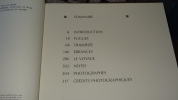



![Les grands voyageurs. Les plus grands textes de Marco Polo et Christophe Colomb à Théodore Monod. Jean DANIEL ] Sous la direction de](https://static.livre-rare-book.com/pictures/MAS/127543_1_thumb.jpg)
